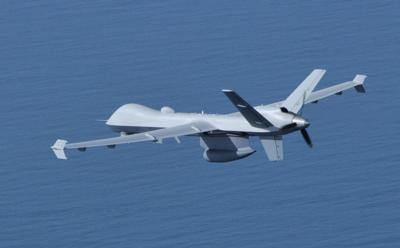Mon, Jun 06, 2016
First Integration And Evaluation Of Due Regard Radar Aboard Customer Aircraft
General Atomics Aeronautical Systems, Inc. (GA-ASI) has announced the successful operational testing of a Detect and Avoid (DAA) system including GA-ASI’s Due Regard Radar (DRR) aboard a U.S. Customs and Border Protection (CBP) Guardian Unmanned Aircraft System (UAS), a maritime variant of GA-ASI’s Predator B RPA. The DAA system also includes Honeywell’s Traffic Alert and Collision Avoidance System (TCAS) and Sensor Tracker, specifically designed for DAA.

“The successful completion of our anti-collision radar system operational testing by CBP is a huge milestone for our DAA system as it represents the first integration and evaluation of DRR on an operational UAS,” said David R. Alexander, president, Aircraft Systems, GA-ASI. “CBP’s follow-on operational use of the DAA system in domestic and international airspace will further validate the work being done by the FAA and NASA to introduce RPA into the National Airspace System.”
Installed on a Guardian UAS in cooperation with CBP, these tests demonstrated DRR’s functionality in the national and international airspace operational environment. DAA scenarios included “intruder” aircraft such as a Cessna C-210 and UH-60 Black Hawk equipped with a mix of Mode A/C Transponders, TCAS, and Automatic Dependent Surveillance-Broadcast (ADS-B) transponder capabilities flying close to Guardian.
During each encounter, onboard sensor data was combined and downlinked to the pilot’s traffic display with DAA-specific alerts and guidance, ensuring safe separation between Guardian and the intruder aircraft. The initial overland testing began at GA-ASI’s Gray Butte Flight Operations facility near Palmdale, CA on March 10 and concluded April 25 over the eastern Pacific Ocean. The tests confirmed that the DAA system provided the RPA pilot with a clear picture of surrounding air traffic, at least as good as “eyes in the cockpit” of a manned aircraft. They also proved the DAA system’s ability to be operated in concert with other radar payloads on the same aircraft, such as Guardian’s SeaVue maritime surface search radar.
CBP operates nine Predator B and Guardian aircraft and is the first customer to employ GA-ASI’s DAA/DRR system in an operational environment. The successful operational testing of DRR aboard Guardian coincides with continued Predator B flight demonstrations conducted in partnership with the FAA, NASA, and industry partners. This work is helping to define airspace regulations that will allow further integration of RPA/UAS into civilian airspace.
(Source: General Atomics news release. Image from file)
More News
From 2023 (YouTube Version): Legacy of a Titan Robert (Bob) Anderson Hoover was a fighter pilot, test pilot, flight instructor, and air show superstar. More so, Bob Hoover was an i>[...]
Get The Latest in Aviation News NOW on Instagram Are you on Instagram yet? It's been around for a few years, quietly picking up traction mostly thanks to everybody's new obsession >[...]
Aero Linx: B-52H Stratofortress The B-52H Stratofortress is a long-range, heavy bomber that can perform a variety of missions. The bomber is capable of flying at high subsonic spee>[...]
Altimeter Setting The barometric pressure reading used to adjust a pressure altimeter for variations in existing atmospheric pressure or to the standard altimeter setting (29.92).>[...]
"Knowing that we play an active part in bettering people's lives is extremely rewarding. My team and I are very thankful for the opportunity to be here and to help in any way we ca>[...]
 Classic Aero-TV: Remembering Bob Hoover
Classic Aero-TV: Remembering Bob Hoover ANN FAQ: Follow Us On Instagram!
ANN FAQ: Follow Us On Instagram! ANN's Daily Aero-Linx (05.15.24)
ANN's Daily Aero-Linx (05.15.24) ANN's Daily Aero-Term (05.15.24):Altimeter Setting
ANN's Daily Aero-Term (05.15.24):Altimeter Setting Aero-News: Quote of the Day (05.16.24)
Aero-News: Quote of the Day (05.16.24)



